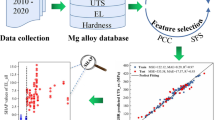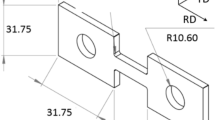Abstract
AZ31 magnesium alloys from different suppliers usually have different chemistry and processing histories, causing variance in their mechanical properties. In this work, we establish the quantitative relationship between alloy compositions, processing parameters, and mechanical properties by machine learning. Based on the artificial neural network (ANN) and support vector machine (SVM) algorithms, two models were built using a dataset with 112 data. Both models achieved good accuracy in predicting yield strength (YS), ultimate tensile strength (UTS), and tensile elongation (EL). To test their generalization ability, a new AZ31 extruded alloy was fabricated, with its chemical composition and processing history being documented. The YS, UTS, and EL of this material were measured and compared with model predictions. Relative errors for YS, UTS, and EL were 5.4%, 23%, and 272% by the ANN model, and 28%, 25%, and 143% by the SVM model, respectively. The reasons for the overestimation of the mechanical properties are discussed.





Similar content being viewed by others
References
S. Begum, D.L. Chen, S. Xu, and A.A. Luo, Mater. Sci. Eng. A 517, 334 (2009).
H. Pan, Y. Ren, H. Fu, H. Zhao, L. Wang, X. Meng, and G. Qin, J. Alloys Compd. 663, 321 (2016).
P. Raccuglia, K. Elbert, P. Adler, C. Falk, M. Wenny, A. Mollo, M. Zeller, S. Friedler, J. Schrier, and A. Norquist, Nature 533, 73 (2016).
R. Ramprasad, R. Batra, G. Pilania, A. Mannodi-Kanakkithodi, and C. Kim, npj Comput. Mater. 3, 54 (2017).
Y. Zhang and C. Ling, npj Comput. Mater. 4, 25 (2018).
A. Agrawal and A. Choudhary, APL Mater. 4, 053208 (2016).
A. Rovinelli, M. Sangid, H. Proudhon, and W. Ludwig, Npj Comput. Mater. 4, 35 (2018).
Z. Tong, L. Wang, G. Zhu, and X. Zeng, Metall. Mater. Trans. A 50A, 5543 (2019).
C. Shen, C. Wang, X. Wei, Y. Li, S.V.D. Zwaag, and W. Xu, Acta Mater. 179, 201 (2019).
C. Wen, Y. Zhang, C. Wang, D. Xue, Y. Bai, S. Antonov, L. Dai, T. Lookman, and Y. Su, Acta Mater. 170, 109 (2019).
B. DeCost, T. Francis, and E. Holm, Acta Mater. 133, 30 (2017).
Z. Chen and S. Daly, Mater. Sci. Eng. A 736, 61 (2018).
Y. Wang and H. Choo, Acta Mater. 81, 83 (2014).
Y. Chino, M. Mamoru, R. Kishihara, H. Hosokawa, Y. Yamada, C. Wen, K. Shimojima, and H. Iwasaki, Mater. Trans. 43, 2254 (2002).
Y. Wang, C. Chang, C. Lee, H.K. Lin, and J.C. Huang, Scr. Mater. 55, 637 (2006).
S. Liang, Z. Liu, and E. Wang, Rare Met. Mater. Eng. 46, 1411 (2017).
A. Yamashita, Z. Horita, and T. Langdon, Mater. Sci. Eng. A 300, 142 (2001).
S. Liang, X. Wang, and Z. Liu, Rare Met. Mater. Eng. 38, 1276 (2009).
H. Luo, Mater. Mech. Eng. 37, 60 (2013).
L. Shi, J. Li, and Y. Li, Forg. Stamp. Technol. 34, 35 (2009).
P. Wu and X. Dai, Hot Work. Technol. 46, 136 (2017).
C. Zhao, G. Wang, and Y. Huang, Hot Work. Technol. 44, 231 (2015).
H. Lu. Master Thesis. Taiyuan University of Science and Technology (2017).
P. Tan, M. Steinbach, and V. Kumar, Introduction to Data Mining (New York: Pearson, 2005).
https://pytorch.org/tutorials/beginner/blitz/autograd_tutorial.html.
K. He, X. Zhang, S. Ren, and J. Sun, Proceedings of the IEEE international conference on computer vision, 1026 (2015).
A. Géron, Hands-On Machine Learning with Scikit-Learn, Keras, and TensorFlow: Concepts, Tools, and Techniques to Build Intelligent Systems (Sebastopol, CA: O’Reilly Media, 2019).
G. Zhu, L. Wang, H. Zhou, J. Wang, Y. Shen, P. Tu, H. Zhu, W. Liu, P. Jin, and X. Zeng, Int. J. Plasticity 120, 164 (2019).
H. Yu, C. Li, Y. Xin, A. Chapuis, X. Huang, and Q. Liu, Acta Mater. 128, 313 (2017).
Z.R. Zeng, Y.M. Zhu, R.L. Liu, S.W. Xu, C.H.J. Davies, J.F. Nie, and N. Birbilis, Acta Mater. 160, 97 (2018).
Acknowledgements
This work is financially supported by a collaborative research project (No. 18X120010001) between the University of Michigan and Shanghai Jiao Tong University which applies data science to Mg alloy design. We also acknowledge support from the National Key Research and Development Program of China (No. 2016YFB0701203) and the Science and Technology Commission of Shanghai Municipality (No. 18511109302).
Author information
Authors and Affiliations
Corresponding author
Ethics declarations
Conflict of interest
The authors declare that they have no conflict of interest.
Additional information
Publisher's Note
Springer Nature remains neutral with regard to jurisdictional claims in published maps and institutional affiliations.
Rights and permissions
About this article
Cite this article
Xu, X., Wang, L., Zhu, G. et al. Predicting Tensile Properties of AZ31 Magnesium Alloys by Machine Learning. JOM 72, 3935–3942 (2020). https://doi.org/10.1007/s11837-020-04343-w
Received:
Accepted:
Published:
Issue Date:
DOI: https://doi.org/10.1007/s11837-020-04343-w




